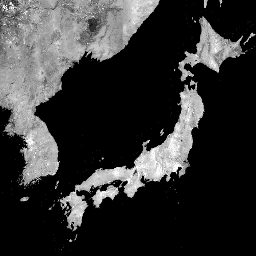
- 데이터 세트 제공
- 2015-01-01T00:00:00Z–2024-01-01T00:00:00Z
- 데이터 세트 제공업체
- JAXA EORC
- 태그
설명
글로벌 25m PALSAR/PALSAR-2 모자이크는 PALSAR/PALSAR-2의 SAR 이미지 스트립을 모자이크하여 만든 연속적인 글로벌 SAR 이미지입니다. 각 연도와 위치에 대해 기간 동안 사용할 수 있는 탐색 모자이크를 시각적으로 검사하여 스트립 데이터를 선택했으며, 표면 수분에 대한 반응이 최소인 데이터가 우선적으로 사용되었습니다. 각 연간 모자이크에는 타겟 연도의 데이터만 사용되었으므로 연간 전 세계 범위에 격차가 있는 경우 이전 연도의 데이터를 사용하여 격차를 채우지 않습니다.
ALOS와 ALOS-2 시간 범위 간의 격차로 인해 2011~2014년 데이터가 없습니다.
SAR 이미지는 디지털 표면 모델 ALOS World 3D - 30m (AW3D30)을 사용하여 직교 보정 및 경사 보정되었습니다.
표면 수분 조건의 계절별 및 일별 차이로 인해 주로 발생하는 인접한 스트립 간의 강도 차이를 균등화하기 위해 디스트라이핑 프로세스 (Shimada & Isoguchi, 2002, 2010)를 적용했습니다.
편광 데이터는 16비트 디지털 번호 (DN)로 저장됩니다. DN 값은 다음 방정식을 사용하여 데시벨 단위 (dB)의 감마 제로 값으로 변환할 수 있습니다.
- γ₀ = 10log₁₀(DN²) - 83.0 dB
주의:
- 역산란 값은 고위도 산림 지역에서 경로에 따라 크게 다를 수 있습니다. 이는 겨울에 나무가 얼어붙어 역산란 강도가 변하기 때문입니다.
자세한 내용은 제공업체의 데이터 세트 설명을 참고하세요.
대역
픽셀 크기
25m
밴드
| 이름 | 단위 | 픽셀 크기 | 설명 |
|---|---|---|---|
HH |
미터 | HH 편광 후방 산란 계수, 16비트 DN입니다. |
|
HV |
미터 | HV 편광 후방 산란 계수, 16비트 DN입니다. |
|
angle |
deg | 미터 | 지역 입사각입니다. |
epoch |
미터 | 관측 날짜 타임스탬프 (1970년 1월 1일 이후 경과된 밀리초)입니다. 이 밴드는 2014년 5월 24일과 관측 날짜 간의 일수 차이를 나타내는 원시 데이터의 'date' 밴드에서 즉석에서 계산됩니다. |
|
qa |
미터 | 정보를 처리하는 중입니다. |
qa Class Table
| 값 | 색상 | 설명 |
|---|---|---|
| 0 | #000000 | 데이터 없음 |
| 50 | #0000ff | 바다와 물 |
| 100 | #aaaa00 | 레이더 오버레이 |
| 150 | #005555 | 레이더 섀도잉 |
| 255 | #aa9988 | 토지 |
이용약관
이용약관
JAXA는 데이터 세트의 소유권을 보유하며 데이터 세트 사용으로 인해 발생하거나 발생할 수 있는 문제에 대해 보증하지 않습니다. 데이터 세트를 사용하여 결과를 게시하려는 사람은 누구나 게시물에서 데이터의 소유권을 명확하게 인정해야 합니다.
인용
Masanobu Shimada, Takuya Itoh, Takeshi Motooka, Manabu Watanabe, Shiraishi Tomohiro, Rajesh Thapa, Richard Lucas, 'New Global Forest/Non-forest Maps from ALOS PALSAR Data (2007-2010)', Remote Sensing of Environment, 155, pp. 13~31, 2014년 12월. doi:10.1016/j.rse.2014.04.014.
Earth Engine으로 탐색
코드 편집기(JavaScript)
var dataset = ee.ImageCollection('JAXA/ALOS/PALSAR/YEARLY/SAR_EPOCH') .filter(ee.Filter.date('2017-01-01', '2018-01-01')); var sarHh = dataset.select('HH'); var sarHhVis = { min: 0.0, max: 10000.0, }; Map.setCenter(136.85, 37.37, 4); Map.addLayer(sarHh, sarHhVis, 'SAR HH');
